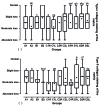The healing effect of bioglue in articular cartilage defect of femoral condyle in experimental rabbit model
- PMID: 22737537
- PMCID: PMC3372013
- DOI: 10.5812/kowsar.20741804.2254
The healing effect of bioglue in articular cartilage defect of femoral condyle in experimental rabbit model
Abstract
Background: The full-thickness articular cartilage defects of knee have a poor healing capacity that may progress to osteoarthritis and need a knee replacement. This study determines the healing effect of bioglue in fullthickness articular cartilage defect of femoral condyle in rabbit.
Methods: Forty-eight male rabbits were randomly divided into four equal groups. In group A, 4 mm articular cartilage defects were created in the right and left medial femoral condyles. Then a graft from xiphoid cartilage was transferred into the defect together with a designed bioglue and the knees were closed. In group B, an articular cartilage defect was created identical to group A, but the defect size was 6 mm. In group C, 4 and 6 mm articular cartilage defects were created in the right and left medial femoral condyles respectively. The graft was transferred into the defect and the knees were stitched. In group D, articular cartilage defects were created similar to group C, just filled with bioglue and closed. The rabbits were euthanized and subgroups were defined as A1, B1, C1 and D1 after 30 days and A2, B2, C2 and D2 after 60 days. The cartilages were macroscopically and histologically investigated for any changes.
Results: Microscopic and macroscopic investigations showed that bioglue had a significant healing effect in the femoral condyle.
Conclusion: Addition of bioglue can effectively promote the healing of articular cartilage defects.
Keywords: Articular Cartilage; Bioglue; Defect; Femoral Condyle; Healing; Rabbit.
Conflict of interest statement
Figures







Similar articles
-
[In vitro effect of alendronate on chondrocytes and articular cartilage and subchondral bone in rabbit anterior cruciate ligament transection model].Zhongguo Xiu Fu Chong Jian Wai Ke Za Zhi. 2009 Dec;23(12):1474-81. Zhongguo Xiu Fu Chong Jian Wai Ke Za Zhi. 2009. PMID: 20073314 Chinese.
-
Spontaneous repair of full-thickness defects of articular cartilage in a goat model. A preliminary study.J Bone Joint Surg Am. 2001 Jan;83(1):53-64. doi: 10.2106/00004623-200101000-00008. J Bone Joint Surg Am. 2001. PMID: 11205859
-
The repair of full-thickness articular cartilage defect using intra-articular administration of N-acetyl-D-glucosamine in the rabbit knee: randomized controlled trial.Biomed Eng Online. 2015 Nov 18;14:105. doi: 10.1186/s12938-015-0100-y. Biomed Eng Online. 2015. PMID: 26582033 Free PMC article.
-
The positive impact of platelet-derived growth factor on the repair of full-thickness defects of articular cartilage.Eklem Hastalik Cerrahisi. 2019 Aug;30(2):91-6. doi: 10.5606/ehc.2019.64018. Eklem Hastalik Cerrahisi. 2019. PMID: 31291855
-
Influence of platelet time activation on articular cartilage growth in the rabbit knee: preliminary study.Knee. 2008 Aug;15(4):314-7. doi: 10.1016/j.knee.2008.02.006. Epub 2008 Apr 11. Knee. 2008. PMID: 18406619
Cited by
-
Tissue Engineering in Maxillary Bone Defects.World J Plast Surg. 2018 Jan;7(1):3-11. World J Plast Surg. 2018. PMID: 29651386 Free PMC article.
-
The effect of sodium hyaluronate-chondroitin sulfate combined solution on cartilage formation in osteochondral defects of the rabbit knee: an experimental study.Ther Clin Risk Manag. 2017 Apr 18;13:523-532. doi: 10.2147/TCRM.S133635. eCollection 2017. Ther Clin Risk Manag. 2017. PMID: 28458555 Free PMC article.
-
The Healing Effect of Bone Marrow-Derived Stem Cells in Knee Osteoarthritis: A Case Report.World J Plast Surg. 2016 May;5(2):168-74. World J Plast Surg. 2016. PMID: 27579273 Free PMC article.
-
Application of Stichopus hermanni Nanoparticle Gel in the Healing of Traumatic Ulcers.Eur J Dent. 2023 May;17(2):330-336. doi: 10.1055/s-0042-1759884. Epub 2023 Jan 23. Eur J Dent. 2023. PMID: 36690026 Free PMC article.
-
The Healing Effect of Adipose-Derived Mesenchymal Stem Cells in Full-thickness Femoral Articular Cartilage Defects of Rabbit.Int J Organ Transplant Med. 2015;6(4):165-75. Epub 2015 Nov 1. Int J Organ Transplant Med. 2015. PMID: 26576262 Free PMC article.
References
-
- Padua R, Bondì R. Focal articular cartilage defects of the knee: surgical treatment. J Orthop Traumatol. 2004;5:63–5. doi: 10.1007/s10195-004-0043-8. - DOI
-
- Carranza-Bencano A, García-Paino L, Armas Padrón JR, Cayuela Dominguez A. Neochondrogenesis in repair of full-thickness articular cartilage defects using free autogenous periosteal grafts in the rabbit. A follow-up in six months. Osteoarthritis Cartilage. 2000;8:351–8. doi: 10.1053/joca.1999.0309. - DOI - PubMed
-
- Sánchez M, Anitua E, Azofra J, Andía I, Padilla S, Mujika I. Comparison of surgically repaired Achilles tendon tears using plateletrich fibrin matrices. Am J Sports Med. 2007;35:245–51. - PubMed
LinkOut - more resources
Full Text Sources
Miscellaneous
